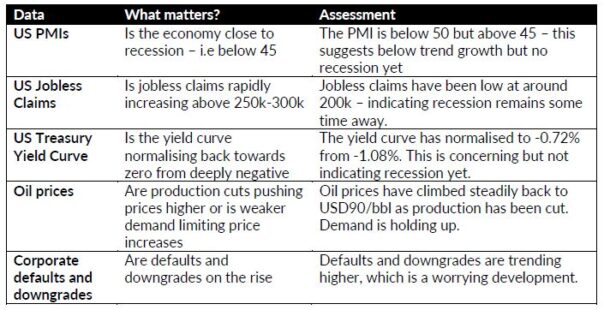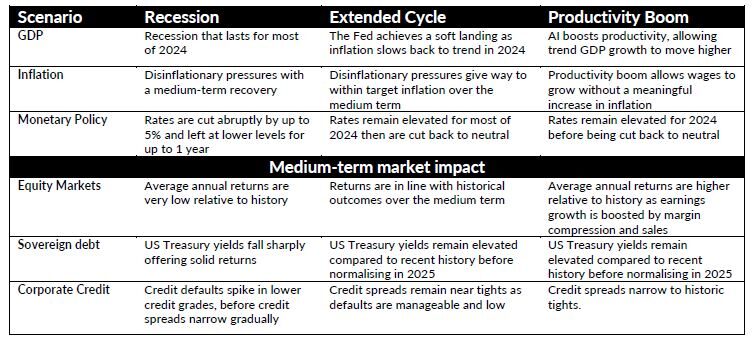Why revisiting scenarios now is important for investors
Market Insight
19/09/2023
Global central banks are either at the end of their rate hike cycle, or near it. The US Federal Reserve, the European Central Bank, the Bank of England and the Reserve Bank of Australia are probably set to leave rates unchanged at restrictive levels for some time. Historically, the end of a rate hike cycle gave way to recession within 6-18 months. The consensus now expects this time to be different. A soft landing is expected, where recession is avoided. We prefer not to have to rely on the argument that this time is different. Instead, we have relied on our scenario analysis to ask how the global economy may unfold over the coming 18 months, to guide our investment decisions.
We have built three scenarios that are plausible.
Table 1 below shows three scenarios that we think are plausible. The recession scenario describes a typical recession that has historically followed the end of the rate hike cycle. We think it is the most likely outcome over the coming 18 months. The extended cycle is the soft-landing consensus. We are sceptical that this can be achieved, even though we hope central banks can side-step history and manage to avoid recession. The productivity boom scenario acknowledges the recent AI frenzy, and imagines a world where years of poor developed-world productivity is reversed as a function of the AI revolution.
Table 1: Three plausible scenarios for investors.
Use data to gauge the likelihood of each scenario.
We do not know with any confidence the probability of each scenario being the right scenario. And these scenarios may sit on the same or different probability distribution, making quantitative modelling difficult. So rather than assign probabilities, we have focused on a series of data that can help gauge which scenario is relatively more likely.
We can Bayesian update these relative likelihoods to reflect that new information in real time. Table 2 captures the data we are focused on.
Table 2: Key economic indicators to gauge the likelihood of each scenario.

Markets are priced for perfection, not for risk.
Equity markets have driven higher in recent months. But they are not discounting the risk of earnings or an economic recession. Multiples look stretched and vulnerable to re-rating in the case of a sudden economic slowdown. With PMI’s trending lower and corporate defaults and downgrades ticking up, risks are to the downside and equity investors may be punished if earnings miss expectations.
Current credit spread levels do not compensate investors for the growing risk of credit rating downgrades and defaults. This is especially the case in the lower high yield credit universe. Investment grade may remain somewhat insulated. But credit quality in investment grade has also deteriorated over recent years and we think there is risk of spread widening. That leaves significant downside risk to total returns in the near- to medium-term.
Government bonds are priced for 4 rate cuts next year – which is in line with a soft landing. The yield curve has steepened in recent months. Historically, a normalization of the yield curve from inversion has coincided with a recession. That leaves government bonds vulnerable to a rapid repricing of rate cuts to a more typical recession. In a recession, central banks cut rates dramatically, with government bond yields typically falling at a similar rate.
How can we use scenarios to manage portfolio risk?
Given markets are already priced for the soft-landing consensus, the risks are that it is disappointed. We can use these scenarios to manage that risk.
Equity markets are priced for the soft-landing scenario. They are probably also priced for the productivity boom scenario, given the rapid run up in AI related equity prices.That suggests treating equity risk with caution, and adopting a bias to reduce risk into equity market rallies.
Credit risk is similarly priced for both the soft landing and productivity boom scenarios. We suggest taking short spread duration against the risk these expectations are confounded.
Government bond yields are elevated and offer good income. They are likely underpricing the likelihood that the Fed cuts rates next year – even in the soft landing scenario and productivity boom scenarios, inflation will slow allowing rate cuts. Government bonds look attractive in all three scenarios.
Monitor and act as more information is released.
The outlook is uncertain. We are potentially near the end of the cycle. Scenarios are a useful way to manage portfolios and to understand investment risk and market vulnerabilities. We suggest reviewing these scenarios or considering other scenarios as a sensible portfolio management tool in this environment.
Contact PAS for more information.
The Portfolio Advisory Service has been working with investors across Australia and Asia to help manage investment solutions. This includes a clear move towards managed accounts within the Australian and Hong Kong markets, as well as a focus on investment governance and investment process. The Portfolio Advisory Service can help build custom-made investment solutions including managed accounts, or by providing access to our own range of Active Alpha, Active Beta Plus and Active Beta portfolios. Our work is supported by deep asset class research and manager review expertise within the team – delivering great outcomes for our partners. Reach out to our Portfolio Advisory Service to find out how we can assist you with managing your investment challenges.



